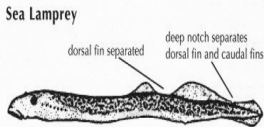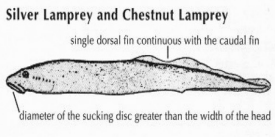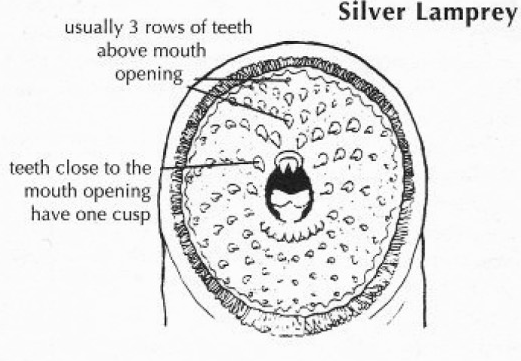Facts
Silver Lamprey are often misidentified for the invasive species Petromyzon marinus, more commonly known as the Sea Lamprey. Sea Lampreys are an invasive species to the great lakes areas. Like Silver Lampreys, Sea Lampreys also are parasitic organisms feeding by attaching themselves to fish. They were able to enter the great lakes from the Atlantic Ocean through man made canals and locks(Sea Lamprey(Petromyzon marinus)).

Sea Lamprey have no commercial value and no know predators in the great lakes. Sea Lamprey feed on whitefish, lake trout, chub, rainbow trout, yellow perch, burbot, walleye and catfish(Minnesota Sea Grant) in the great lakes. In the 1940's and 1950's the Sea Lamprey populations within the great lakes exploded and had a devastating effect on the game fish within the great lakes(Minnesota Sea Grant). A Sea Lamprey can eat up to 40lbs of fish within its life time and it is estimated that only 1 in 7 fish that a Sea Lamprey attach to will survive(Minnesota Sea Grant).
There are several ways in which Silver Lampreys can be distinguished from a
Sea Lamprey. First the Silver Lamprey and Sea Lamprey have different
dorsal fins. Silver Lamprey has an a divided dorsal fin, while a Sea
Lampreys dorsal fin is divided into two segments(Michigan Sea Grant).
A second way that Silver Lamprey and Sea Lamprey can be distinguished is by
the arrangement of their teeth. Silver lamprey typically have three rows
of teeth at the top of the mouth and the teeth directly surrounding the mouth
have one cuspid. Sea Lampreys have two teeth very close together at the
top of the mouth and have four sets of teeth that are cuspid(Michigan Sea Grant).
Silver Lamprey and Sea Lamprey can also be identified by looking at genetic markers in ammocetes. Ammocetes are often collected and counted to find Sea Lamprey populations. Ammocetes of Silver Lamprey and Sea Lamprey look very similar, so testing for genetic markers is the best way to tell the two species apart(Filcek, F).
For more information visit Minnesota Sea Grant , Minnesota DNR, Michigan Sea Grant

